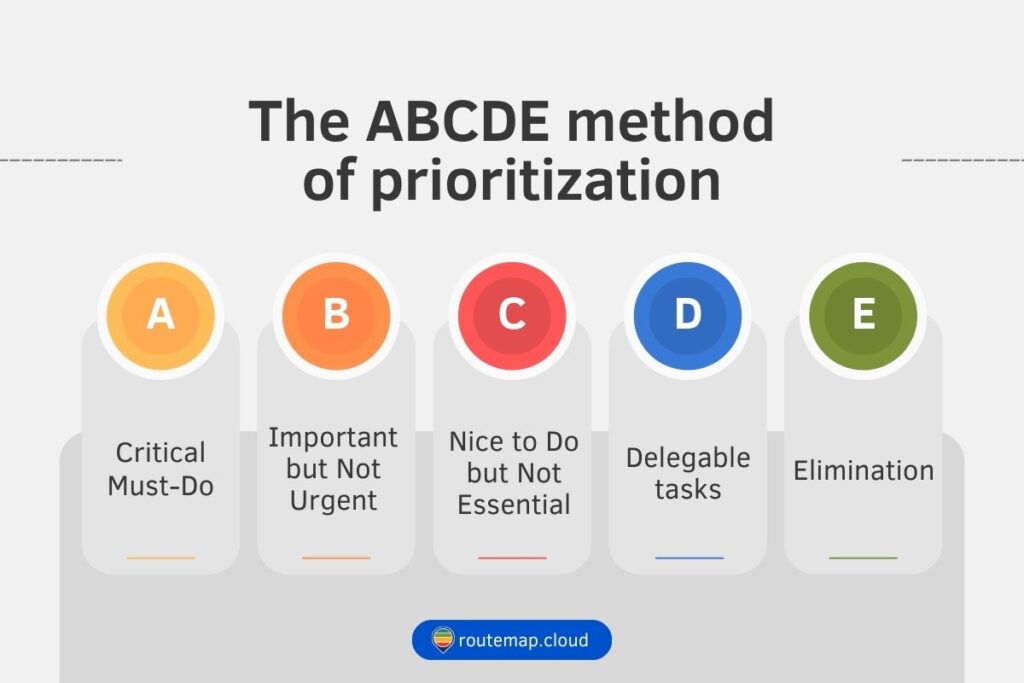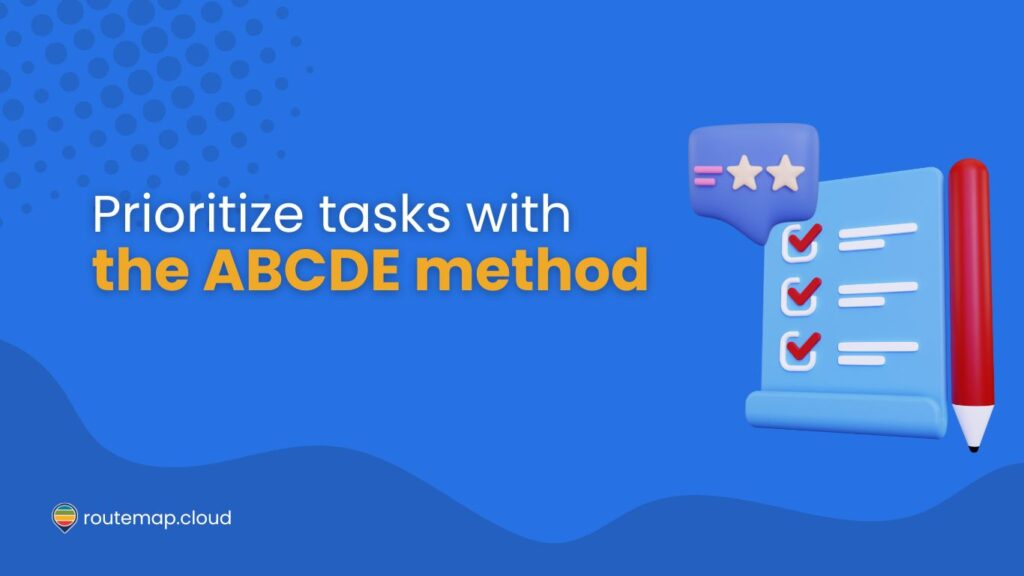When it comes to tight deadlines and plentiful tasks, it is crucial to find a method to prioritize effectively for any project management team aiming for success. This is where the ABCDE method comes into place.
It is a simple yet profound strategy for sorting tasks that light the way to optimal productivity. Additionally, this prioritization method ensures the most critical projects are delivered with excellence.
Let’s explore how the ABCDE method can transform your project management approach.
Table of Content
Overview of the ABCDE method
The ABCDE method is more than just a prioritization matrix or framework. It is a strategic approach to task management that empowers professionals to make informed decisions about where to focus their efforts.

By categorizing tasks based on their urgency and importance, this method illuminates the path to efficiency. Additionally, it can enable project teams to tackle their workloads with precision and confidence.
As a result, teams can transform their project management practices, leading to remarkable improvements in personal and team productivity.
Breakdown of each category in the ABCDE method
1. A equals Critical Must-Do tasks
Tasks labeled as “A” are the linchpins of your project. These are the non-negotiables, the tasks that demand immediate attention and action. Failure to complete these tasks could result in significant setbacks or even derail the project altogether.
Identifying and addressing “A” tasks ensures that your team focuses its energy on activities that are critical for success.
2. B indicates Important but Not Urgent tasks
“B” tasks are important but lack the immediate urgency of “A” tasks. These activities contribute to the project’s long-term goals and require attention once all “A” tasks are under control.
Managing “B” tasks effectively prevents future crises and keeps the project on track toward its milestones.
3. C – Nice to Do but Not Essential
“C” tasks are beneficial but not vital. These are the tasks that, while they might enhance the project or process, won’t have a drastic impact if left undone. Prioritizing “C” tasks too highly can divert valuable resources from more critical tasks, so they should only be tackled when “A” and “B” tasks are completed.
4. D means Delegable tasks
“D” tasks are important but not necessarily required to be done by you or your immediate team. Delegating these tasks to others can free up your time for activities that only you can perform.
Moreover, effective delegation requires clear communication and trust in your team’s abilities, fostering a collaborative environment that elevates the entire project.
5. E stands for Elimination
“E” tasks are those that, upon closer inspection, offer little to no value to the project’s outcomes. Eliminating these tasks from your to-do list can clear mental space and ensure that the team’s focus remains on high-impact activities.
Therefore, being ruthless in eliminating “E” tasks can dramatically streamline operations and focus efforts where they matter most.
How to implement the ABCDE method for prioritizing tasks
Implementing the ABCDE method within a project management context involves a structured approach that maximizes team efficiency and effectiveness. This method not only helps in prioritizing tasks but also ensures that every team member understands their responsibilities clearly.
Here’s a deeper dive into how to effectively apply the ABCDE method in your project management processes.
1. Gather and list all tasks
You can start by compiling a comprehensive list of all tasks associated with the project. This can be done through a collaborative effort with your team to ensure no task is overlooked.
Utilize project management software or simple tools like spreadsheets to organize these tasks in one place. The goal here is to have a clear overview of everything that needs to be accomplished.
2. Initial categorization
Once all tasks are listed, begin the initial phase of categorization. This step involves assigning each task to one of the ABCDE categories.
Moreover, you should encourage team discussions during this process. Different perspectives can help in accurately determining the priority and urgency of each task.
Remember, the categorization is not set in stone and can be adjusted as the project progresses.
3. Prioritizing within categories
Once finished categorizing tasks, you can focus on prioritizing them within their respective categories, starting with “A” tasks. For “A” tasks, determine which needs immediate attention and order them accordingly.
Then, you can apply similar prioritization for “B” tasks, keeping in mind their importance in the longer term.
4. Regular review and adjustment
The dynamic nature of projects means that the priority of tasks can change. Therefore, it is recommended to regularly review the task list and the ABCDE categorization to reflect the current project status and priorities.
This could mean moving tasks between categories or adjusting the order of priority within a category.
5. Effective delegation and follow-up
For “D” tasks that have been delegated, you should ensure a clear understanding of expectations and deadlines. Besides, regular follow-ups and check-ins can help keep these tasks on track without micromanaging.
Additionally, you can also empower your team by trusting them to complete the tasks and providing support when needed.
6. Communication and transparency
You should maintain open lines of communication throughout the ABCDE method implementation. Moreover, transparency about how tasks are prioritized and reassigned ensures that all team members are on the same page and can adjust their focus and efforts accordingly.
7. Utilize tools and resources
It is advisable to leverage project management tools and resources to track the progress of tasks across the ABCDE categories. Digital tools can offer features like task labels, deadlines, and progress tracking, making it easier to manage and visualize priorities.
Advantages of using the ABCDE method
Adopting the ABCDE method can revolutionize the way your project management team operates. Immediate benefits include a clearer focus on high-priority tasks, reduced stress from overcommitment, and a more strategic approach to task management.
In the long run, this method fosters a culture of productivity and accountability, where team members feel empowered to contribute their best work towards the project’s success.
Tips to maximize its efficiency in project management
For project management teams, it is essential to integrate the ABCDE method with advanced strategies and tools to elevate their efficiency and effectiveness. As a result, they can unlock new levels of productivity.
Here, we delve into advanced tips that complement this prioritization technique.
1. Advanced strategies for integrating digital tools
Incorporating digital project management tools into the ABCDE method can significantly improve task visibility and team collaboration. Platforms such as Trello, Asana, or Jira offer functionalities that align well with this framework, allowing tasks to be easily categorized, prioritized, and updated in real time.
Utilizing these tools, teams can assign labels or tags to tasks based on their ABCDE category, making it simple to filter and focus on tasks that require immediate attention.
Furthermore, setting up automated reminders for deadlines ensures that critical “A” tasks are completed on time, enhancing the team’s ability to meet project milestones.
2. Enhancing team collaboration through the ABCDE method
Effective communication is paramount in ensuring that the ABCDE method is successfully implemented within a project management team.
More specifically, this encourages regular team meetings or stand-ups where members can discuss their progress on “A” and “B” tasks. Then, everyone can share insights on potential “D” tasks for delegation and decide collectively on “E” tasks that can be eliminated.
Therefore, teams can foster a collaborative environment where members feel supported and accountable for their contributions. Additionally, adopting collaborative tools that support real-time communication and task tracking can further streamline this process, ensuring that everyone is aligned on priorities and progress.
3. Continuous improvement and adaptation
The key to maximizing efficiency with the ABCDE method lies in continuous evaluation and adaptation of the process. Encourage team members to provide feedback on the prioritization process and suggest improvements.
Besides, this could involve reevaluating the criteria for categorizing tasks and introducing sub-categories for more granular prioritization. Or, you can also adjust workflows to better accommodate changing project dynamics.
Regularly reviewing the effectiveness of the ABCDE method in meeting project goals will allow the team to refine their approach and adopt best practices that enhance productivity and project success.
4. Leveraging the ABCDE method for long-term planning
While the ABCDE method is highly effective for managing daily tasks and short-term priorities, it can also be applied to long-term planning and goal setting. By extending the principles of the ABCDE method to the planning of project phases or milestones, teams can ensure that long-term objectives are aligned with daily priorities.
This holistic approach ensures that immediate tasks contribute to the overarching goals of the project, fostering a sense of purpose and direction among team members.
Conclusion
The ABCDE method offers a simple yet powerful way to navigate the complexities of task prioritization. By categorizing tasks with intention and focus, project teams can achieve more in less time, turning productivity into their competitive advantage.
The key to success lies not just in identifying which tasks to tackle first. It also involves recognizing the importance of adaptability, communication, and the strategic use of digital tools to enhance collaboration and efficiency.
As teams refine their approach to the ABCDE method, they’ll discover a marked improvement in project outcomes and a stronger, more cohesive team dynamic.






